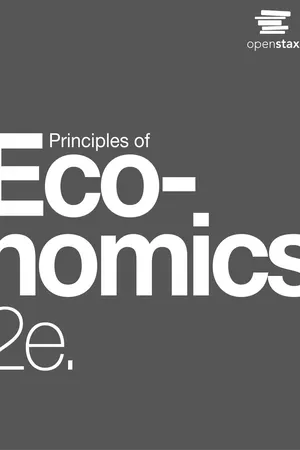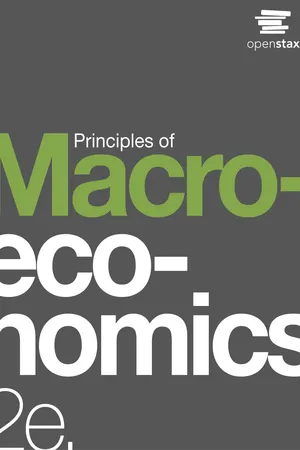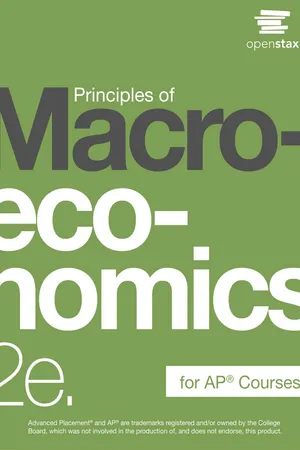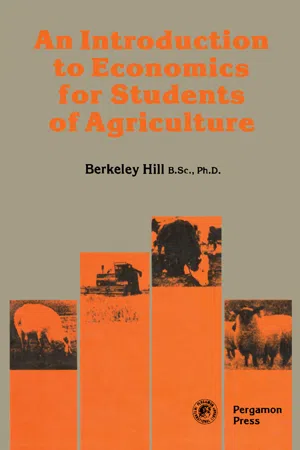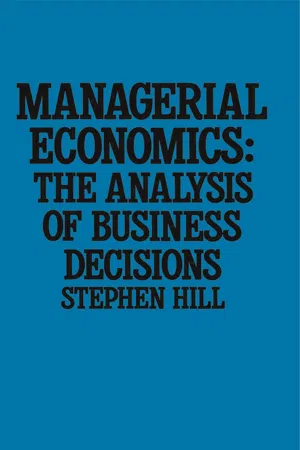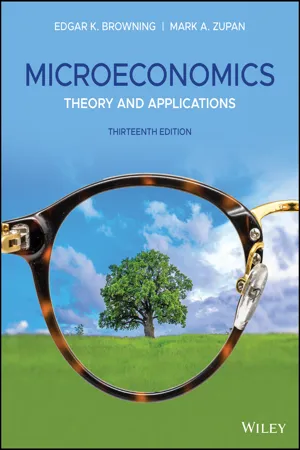Economics
Demand
Demand refers to the quantity of a good or service that consumers are willing and able to purchase at various prices during a specific period. It is influenced by factors such as consumer preferences, income levels, and the prices of related goods. The law of demand states that as the price of a good decreases, the quantity demanded increases, and vice versa.
Written by Perlego with AI-assistance
Related key terms
1 of 5
11 Key excerpts on "Demand"
- eBook - PDF
- Steven A. Greenlaw, Timothy Taylor, David Shapiro(Authors)
- 2017(Publication Date)
- Openstax(Publisher)
The likely reason is that people drive more in the summer, and are also willing to pay more for gas, but that does not explain how steeply gas prices fell. Other factors were at work during those 18 months, such as increases in supply and decreases in the Demand for crude oil. This chapter introduces the economic model of Demand and supply—one of the most powerful models in all of economics. The discussion here begins by examining how Demand and supply determine the price and the quantity sold in markets for goods and services, and how changes in Demand and supply lead to changes in prices and quantities. 3.1 | Demand, Supply, and Equilibrium in Markets for Goods and Services By the end of this section, you will be able to: • Explain Demand, quantity Demanded, and the law of Demand • Identify a Demand curve and a supply curve • Explain supply, quantity supplied, and the law of supply • Explain equilibrium, equilibrium price, and equilibrium quantity First let’s first focus on what economists mean by Demand, what they mean by supply, and then how Demand and supply interact in a market. 46 Chapter 3 | Demand and Supply This OpenStax book is available for free at http://cnx.org/content/col12122/1.4 Demand for Goods and Services Economists use the term Demand to refer to the amount of some good or service consumers are willing and able to purchase at each price. Demand is fundamentally based on needs and wants—if you have no need or want for something, you won't buy it. While a consumer may be able to differentiate between a need and a want, but from an economist’s perspective they are the same thing. Demand is also based on ability to pay. If you cannot pay for it, you have no effective Demand. By this definition, a homeless person probably has no effective Demand for shelter. What a buyer pays for a unit of the specific good or service is called price. The total number of units that consumers would purchase at that price is called the quantity Demanded. - eBook - PDF
- Steven A. Greenlaw, Timothy Taylor, David Shapiro(Authors)
- 2017(Publication Date)
- Openstax(Publisher)
The likely reason is that people drive more in the summer, and are also willing to pay more for gas, but that does not explain how steeply gas prices fell. Other factors were at work during those six months, such as increases in supply and decreases in the Demand for crude oil. This chapter introduces the economic model of Demand and supply—one of the most powerful models in all of economics. The discussion here begins by examining how Demand and supply determine the price and the quantity sold in markets for goods and services, and how changes in Demand and supply lead to changes in prices and quantities. 3.1 | Demand, Supply, and Equilibrium in Markets for Goods and Services By the end of this section, you will be able to: • Explain Demand, quantity Demanded, and the law of Demand • Identify a Demand curve and a supply curve • Explain supply, quantity supplied, and the law of supply • Explain equilibrium, equilibrium price, and equilibrium quantity First let’s first focus on what economists mean by Demand, what they mean by supply, and then how Demand and supply interact in a market. 46 Chapter 3 | Demand and Supply This OpenStax book is available for free at http://cnx.org/content/col12190/1.4 Demand for Goods and Services Economists use the term Demand to refer to the amount of some good or service consumers are willing and able to purchase at each price. Demand is fundamentally based on needs and wants—if you have no need or want for something, you won't buy it. While a consumer may be able to differentiate between a need and a want, but from an economist’s perspective they are the same thing. Demand is also based on ability to pay. If you cannot pay for it, you have no effective Demand. By this definition, a homeless person probably has no effective Demand for shelter. What a buyer pays for a unit of the specific good or service is called price. The total number of units that consumers would purchase at that price is called the quantity Demanded. - Steven A. Greenlaw, Timothy Taylor, David Shapiro(Authors)
- 2017(Publication Date)
- Openstax(Publisher)
The likely reason is that people drive more in the summer, and are also willing to pay more for gas, but that does not explain how steeply gas prices fell. Other factors were at work during those six months, such as increases in supply and decreases in the Demand for crude oil. This chapter introduces the economic model of Demand and supply—one of the most powerful models in all of economics. The discussion here begins by examining how Demand and supply determine the price and the quantity sold in markets for goods and services, and how changes in Demand and supply lead to changes in prices and quantities. 3.1 | Demand, Supply, and Equilibrium in Markets for Goods and Services By the end of this section, you will be able to: • Explain Demand, quantity Demanded, and the law of Demand • Identify a Demand curve and a supply curve • Explain supply, quantity supplied, and the law of supply • Explain equilibrium, equilibrium price, and equilibrium quantity First let’s first focus on what economists mean by Demand, what they mean by supply, and then how Demand and supply interact in a market. 46 Chapter 3 | Demand and Supply This OpenStax book is available for free at http://cnx.org/content/col23729/1.3 Demand for Goods and Services Economists use the term Demand to refer to the amount of some good or service consumers are willing and able to purchase at each price. Demand is fundamentally based on needs and wants—if you have no need or want for something, you won't buy it. While a consumer may be able to differentiate between a need and a want, but from an economist’s perspective they are the same thing. Demand is also based on ability to pay. If you cannot pay for it, you have no effective Demand. By this definition, a homeless person probably has no effective Demand for shelter. What a buyer pays for a unit of the specific good or service is called price. The total number of units that consumers would purchase at that price is called the quantity Demanded.- eBook - PDF
- Steven A. Greenlaw, Timothy Taylor, David Shapiro(Authors)
- 2017(Publication Date)
- Openstax(Publisher)
The likely reason is that people drive more in the summer, and are also willing to pay more for gas, but that does not explain how steeply gas prices fell. Other factors were at work during those six months, such as increases in supply and decreases in the Demand for crude oil. This chapter introduces the economic model of Demand and supply—one of the most powerful models in all of economics. The discussion here begins by examining how Demand and supply determine the price and the quantity sold in markets for goods and services, and how changes in Demand and supply lead to changes in prices and quantities. 3.1 | Demand, Supply, and Equilibrium in Markets for Goods and Services By the end of this section, you will be able to: • Explain Demand, quantity Demanded, and the law of Demand • Identify a Demand curve and a supply curve • Explain supply, quantity supplied, and the law of supply • Explain equilibrium, equilibrium price, and equilibrium quantity First let’s first focus on what economists mean by Demand, what they mean by supply, and then how Demand and supply interact in a market. 46 Chapter 3 | Demand and Supply This OpenStax book is available for free at http://cnx.org/content/col12170/1.7 Demand for Goods and Services Economists use the term Demand to refer to the amount of some good or service consumers are willing and able to purchase at each price. Demand is fundamentally based on needs and wants—if you have no need or want for something, you won't buy it. While a consumer may be able to differentiate between a need and a want, but from an economist’s perspective they are the same thing. Demand is also based on ability to pay. If you cannot pay for it, you have no effective Demand. By this definition, a homeless person probably has no effective Demand for shelter. What a buyer pays for a unit of the specific good or service is called price. The total number of units that consumers would purchase at that price is called the quantity Demanded. - eBook - PDF
- Irvin B. Tucker, Irvin Tucker(Authors)
- 2016(Publication Date)
- Cengage Learning EMEA(Publisher)
Demand represents the choice-making behavior of consumers, while supply represents the choices of producers. The chapter begins by looking closely at Demand and then supply. Finally, it combines these forces to see how prices and quantities are determined in the marketplace. Market Demand and supply analysis is the basic tool of microeconomic analysis. IN THIS CHAPTER, YOU WILL LEARN TO SOLVE THESE ECONOMICS PUZZLES: • What is the difference between a “ change in quantity Demanded ” and a “ change in Demand ” ? • Can Congress repeal the law of supply to control oil prices? • Does the price system eliminate scarcity? Copyright 2017 Cengage Learning. All Rights Reserved. May not be copied, scanned, or duplicated, in whole or in part. Due to electronic rights, some third party content may be suppressed from the eBook and/or eChapter(s). Editorial review has deemed that any suppressed content does not materially affect the overall learning experience. Cengage Learning reserves the right to remove additional content at any time if subsequent rights restrictions require it. ............................................................................................................................................................................................. ............................................................................................................................................................................................. 3-1 THE LAW OF Demand Economics might be referred to as “ graphs and laughs ” because economists are so fond of using graphs to illustrate Demand, supply, and many other economic concepts. Unfor-tunately, some students taking economics courses say they miss the laughs. Exhibit 1 reveals an important “ law ” in economics called the law of Demand . The law of Demand states there is an inverse relationship between the price of a good and the quantity buyers are willing to purchase in a defined time period, ceteris paribus. - Berkeley Hill(Author)
- 2013(Publication Date)
- Pergamon(Publisher)
For example, if income tax is increased on unmarried men and decreased on married men, leaving in taste towards good Swing in taste away from the good 62 An Introduction to Economics for Students of Agriculture average spendable income unchanged, it could be expected that the Demand for sports cars in the country as a whole would decline but the Demand for family saloons would increase. SHIFTS ALONG THE Demand CURVE AND SHIFTS OF THE WHOLE Demand CURVE FOR A COMMODITY To conclude this section on Demand, it is worth recapitulating on the ways the factors described above affect the Demand curve. A Demand curve shows the quantities of a commodity which consumers are willing and able to take from the market at a range of given prices of the com-modity. If the price of the commodity is altered, because a shift in the supply curve causes the Demand curve and the supply curve to intersect at a different level, more (or less) will be bought; this involves a move-ment along the Demand curve. However, the whole curve will be shifted to the left or right by a change in consumer income, a change in the prices of competitive or complementary goods, changes in taste, popula-tion changes or a change in the distribution of incomes between house-holds. Having considered the Demand for commodities in detail, the same approach will now be adopted to the supply of goods and services. B. The Theory of Supply THE MEANING OF SUPPLY AND FACTORS WHICH DETERMINE IT The supply of a commodity can be defined as the quantity that pro-ducers are willing and able to offer for sale in a given time period. Like Demand, supply is a flow of goods and services. The supply of any good depends on five factors: (a) the price of the good (PA) (b) the prices of other goods which firms could produce or do produce (PB, .... ΛΟ (c) the prices of factors of production i.e.- eBook - PDF
Managerial Economics
The Analysis of Business Decisions
- Stephen Hill(Author)
- 2016(Publication Date)
- Red Globe Press(Publisher)
The second is an examination of how the precise relationship between Demand and those variables can be estimated in a manner that has operational value for decision-making. Demand theory It is not the intention of this chapter to summarise the vast body of knowledge that makes up the economic theory of consumer de-mand. Our purpose, rather, is to extract those parts of Demand theory that can act as guides for commercial decision-making -a much more limited objective. The starting point for Demand theory is an understanding of why consumers buy particular goods. The motivation of individual consumers is a complex psychological matter involving the develop-ment of consumer preferences and tastes, habit formation, the desire to conform to social norms, etc. For our purposes it is sufficient to note that goods are purchased for the satisfaction (or utility) they yield, and that the satisfaction from a particular good is generated by the various characteristics of that good. The principal tool used to analyse Demand is the concept of a Demand function, written as Da = [(X1 ... Xn) where Da is the Demand for good a, f is a general (unspecified) function, and X 1 ... Xn are the variables that influence Demand. Our first task is to identify the particular variables that influence Demand. The problem later will be to transform this general function into a specific one, not only including the variables that influence the Demand for a particular good but also measuring the extent to which Demand is affected. Given the Demand function , the influence of a particular variable upon Demand can be measured by the partial derivative, &D &Xi If this partial derivative is positive, an increase in Xi will lead to an increase in Demand, and conversely for negative partial derivatives. The Demand influencing variable that dominates consumer de-mand theory is the price of the product. The simplest Demand function is - eBook - PDF
Microeconomics
Theory and Applications
- Edgar K. Browning, Mark A. Zupan(Authors)
- 2019(Publication Date)
- Wiley(Publisher)
Learning Objectives • Understand how the behavior of buyers and sellers can be characterized through Demand and supply curves. • Explain how equilibrium price and quantity are determined in a market for a good or service. • Analyze how a market equilibrium is affected by changes in Demand or supply. • Explore the effects of government intervention in markets and how a price ceiling impacts price, quantity supplied, quantity Demanded, and the welfare of buyers and sellers. • Show how elasticities provide a quantitative measure of the responsiveness of quantity Demanded or supplied to a change in some other variable such as price or income. • *Explain the mathematics associated with elasticities. 14 Chapter Two • Supply and Demand • Demand and Supply Curves Markets are composed of buyers and sellers. Our analysis of the behavior of buyers relies on Demand curves; supply curves depict the behavior of sellers. Let’s begin with the buyer, or Demand, side of the market. The Demand Curve The amount of a good that a consumer or a group of consumers wishes to purchase depends on many factors: income, age, occupation, education, experience, buyer preferences, taxes, subsidies, expectations, and so on. It also depends on the price of the good. According to the law of Demand, the lower the price of a good, the larger the quantity consumers wish to pur- chase. To this law we must add an important condition. The relationship will hold only if the other factors affecting consumption, such as income and preferences, do not change at the same time that the good’s price changes. The assumption that all other factors remain constant is an important one to keep in mind when examining many relationships in economics. Figure 2.1 shows a hypothetical market Demand curve for 55-inch flat-screen televisions (TVs). At each possible price, the curve identifies the total quantity desired by consumers. - eBook - PDF
- Tucker, Irvin Tucker(Authors)
- 2016(Publication Date)
- Cengage Learning EMEA(Publisher)
............................................................................................................................................................................................. ............................................................................................................................................................................................. 3-1 THE LAW OF Demand Economics might be referred to as “ graphs and laughs ” because economists are so fond of using graphs to illustrate Demand, supply, and many other economic concepts. Unfor-tunately, some students taking economics courses say they miss the laughs. Exhibit 1 reveals an important “ law ” in economics called the law of Demand . The law of Demand states there is an inverse relationship between the price of a good and the quantity buyers are willing to purchase in a defined time period, ceteris paribus. The law of Demand makes good sense. At a “ sale, ” consumers buy more when the price of merchandise is cut. EXHIBIT 1 An Individual Buyer ’ s Demand Curve for Blu-rays Bob ’ s Demand curve shows how many Blu-rays he is willing to purchase at different possible prices. As the price of Blu-rays declines, the quantity Demanded increases, and Bob purchases more Blu-rays. The inverse relationship between price and quantity Demanded conforms to the law of Demand. 20 5 Price per Blu-ray (dollars) 16 12 8 4 0 10 15 20 Quantity of Blu-rays (per year) A C D B Demand curve An Individual Buyer ’ s Demand Schedule for Blu-rays Point Price per Blu-ray Quantity Demanded (per year) A $20 4 B 15 6 C 10 10 D 5 16 Law of Demand The principle that there is an inverse relationship between the price of a good and the quantity buyers are willing to pur-chase in a defined time period, ceteris paribus. CHAPTER 3 | Market Demand and Supply 59 Copyright 2017 Cengage Learning. All Rights Reserved. May not be copied, scanned, or duplicated, in whole or in part. - eBook - PDF
- David Shapiro, Daniel MacDonald, Steven A. Greenlaw(Authors)
- 2022(Publication Date)
- Openstax(Publisher)
Demand social surplus the sum of consumer surplus and producer surplus substitute a good that can replace another to some extent, so that greater consumption of one good can mean less of the other supply the relationship between price and the quantity supplied of a certain good or service supply curve a line that shows the relationship between price and quantity supplied on a graph, with quantity supplied on the horizontal axis and price on the vertical axis supply schedule a table that shows a range of prices for a good or service and the quantity supplied at each price surplus at the existing price, quantity supplied exceeds the quantity Demanded; also called excess supply total surplus see social surplus Key Concepts and Summary 3.1 Demand, Supply, and Equilibrium in Markets for Goods and Services A Demand schedule is a table that shows the quantity Demanded at different prices in the market. A Demand curve shows the relationship between quantity Demanded and price in a given market on a graph. The law of Demand states that a higher price typically leads to a lower quantity Demanded. A supply schedule is a table that shows the quantity supplied at different prices in the market. A supply curve shows the relationship between quantity supplied and price on a graph. The law of supply says that a higher price typically leads to a higher quantity supplied. The equilibrium price and equilibrium quantity occur where the supply and Demand curves cross. The equilibrium occurs where the quantity Demanded is equal to the quantity supplied. If the price is below the equilibrium level, then the quantity Demanded will exceed the quantity supplied. Excess Demand or a shortage will exist. If the price is above the equilibrium level, then the quantity supplied will exceed the quantity Demanded. Excess supply or a surplus will exist. In either case, economic pressures will push the price toward the equilibrium level. - eBook - PDF
Economics for Investment Decision Makers
Micro, Macro, and International Economics
- Christopher D. Piros, Jerald E. Pinto(Authors)
- 2013(Publication Date)
- Wiley(Publisher)
CHAPTER 2 Demand AND SUPPLY ANALYSIS: CONSUMER Demand Richard V. Eastin Gary L. Arbogast, CFA LEARNING OUTCOMES After completing this chapter, you will be able to do the following: Describe consumer choice theory and utility theory. Describe the use of indifference curves, opportunity sets, and budget constraints in decision making. Calculate and interpret a budget constraint. Determine a consumer’s equilibrium bundle of goods based on utility analysis. Compare substitution and income effects. Distinguish between normal goods and inferior goods, and explain Giffen goods and Veblen goods in this context. 1. INTRODUCTION By now it should be clear that economists are model builders. In the previous chapter, we examined one of their most fundamental models, the model of Demand and supply. And as we have seen, models begin with simplifying assumptions and then find the implications that can then be compared to real-world observations as a test of the model’s usefulness. In the model of Demand and supply, we assumed the existence of a Demand curve and a supply curve, as well as their respective negative and positive slopes. That simple model yielded some very powerful implications about how markets work, but we can delve even more deeply to explore the underpinnings of Demand and supply. In this chapter, we examine the theory of the 59 consumer as a way of understanding where consumer Demand curves originate. In a subse- quent chapter, the origins of the supply curve are sought in presenting the theory of the firm. This chapter is organized as follows: Section 2 describes consumer choice theory in more detail. Section 3 introduces utility theory, a building block of consumer choice theory that provides a quantitative model for a consumer’s preferences and tastes. Section 4 surveys budget constraints and opportunity sets. Section 5 covers the determination of the consumer’s bundle of goods and how that may change in response to changes in income and prices.
Index pages curate the most relevant extracts from our library of academic textbooks. They’ve been created using an in-house natural language model (NLM), each adding context and meaning to key research topics.
